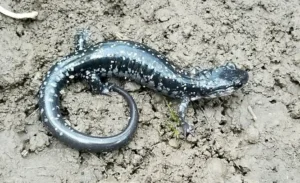Salamanders are quiet, curious creatures that have been around for a very long time. Over millions of years, they have slowly changed to survive in new places and conditions. Their long past helps explain many of the things that make them stand out, like growing back lost limbs or living in both water and on land.
Salamanders evolved from ancient amphibians over 160 million years ago, slowly gaining features that helped them survive in many types of places, both in water and on land.
Put simply, they started off long ago and adapted in many different ways to live where they do now.
Where Salamanders Came From
Salamanders are part of a group called amphibians, which were among the first animals to move out of water and onto land.
Their very early relatives lived hundreds of millions of years ago, back when dinosaurs still roamed the earth.

Fossils show that salamander-like animals were already around during the Jurassic period, which was about 160 million years ago.
These early creatures looked somewhat like the salamanders we see now but also had a few clear differences.
Over many generations, salamanders changed to fit into a wide mix of homes, from damp forests to mountain streams to deep, dark caves.
What Sets Them Apart from Other Amphibians
When you compare salamanders to other amphibians like frogs or toads, there are some obvious differences.
Salamanders usually have long, narrow bodies, tails they keep all their lives, and four legs that are all about the same length. These traits come from their long evolutionary past.

Frogs lose their tails and grow big jumping legs, but salamanders keep their tails and walk or crawl instead. Their soft, wet skin lets them breathe through it, a skill passed down from their early ancestors who lived in damp places.
Their Ability to Grow Back Limbs
One thing that surprises many people is that salamanders can regrow body parts, like legs or tails, after losing them. This is not something most animals can do.
Scientists think this skill started early in their history as a way to escape danger or survive after being attacked.
This gave salamanders a big advantage over other animals that couldn’t recover from such injuries.
Moving from Water to Land
Like other amphibians, salamanders live part of their life in water and part on land. This pattern has been shaped over a long period of time. They started out living mostly in water, but over time, many species learned to spend more of their lives on dry land.
Today, some still live in water almost all the time, while others only return to ponds or streams to lay eggs. Their lungs, skin, and the way they reproduce all reflect this mix of land and water living.
How They Became So Different
As time passed, salamanders split into many different kinds. Each one adapted to its own home and lifestyle. Some species live deep in caves and have lost their eyes completely. Others spend most of their lives in trees and have special toe pads to help them climb.

Those that live in water often keep gills or grow tails shaped for swimming. All of these changes are results of how they evolved to survive in their own unique places.
Their Place in the Animal Family Tree
Salamanders are part of a group called Caudata, which also includes animals like newts. This group is within a larger branch called Lissamphibia, which includes frogs and worm-like animals called caecilians.
By studying fossils, body shapes, and DNA, scientists learn how salamanders are related to other animals. This helps explain where they came from and how they fit into the larger story of life.
How Natural Selection Shaped Them
Natural selection means that animals with helpful traits survive better and pass those traits to their young. In salamanders, things like poisonous skin, hiding colors, and the power to regrow parts made survival more likely.
These traits were passed on more often, helping salamanders handle changes in their homes, predators, and weather.
Different Ways of Reproducing
Not all salamanders have the same way of reproducing. Over time, they developed different methods based on where they live. Some lay eggs in water, and the male fertilizes them outside the body.
Others use a different way called internal fertilization, where the male leaves behind a sperm packet and the female picks it up. These changes helped them succeed in all kinds of environments and keep their young safe.
How Changing Weather Shaped Them
In the past, the earth’s climate has gone through many shifts, like long ice ages. Cold times forced salamanders into smaller areas where only the strongest ones survived.
When things warmed up again, those survivors spread out and became new species. Today’s climate changes could lead to more changes in salamanders, but it’s hard to know exactly how they’ll respond.
Conclusion
Salamanders came from ancient amphibians and slowly changed over millions of years, gaining traits like limb regrowth and a mix of land and water living. Their many forms and ways of life show how much they’ve had to adjust to the world around them.
Studying their past helps us see how nature works over time and why it matters to keep these animals safe. Salamanders may be small and quiet, but they carry a long, rich story written by time and change.
Hi, my name is Ezra Mushala, i have been interested animals all my life. I am the main author and editor here at snakeinformer.com.

